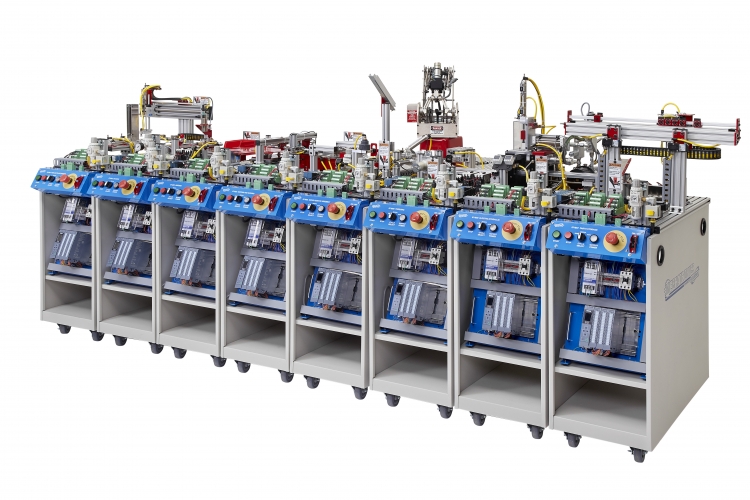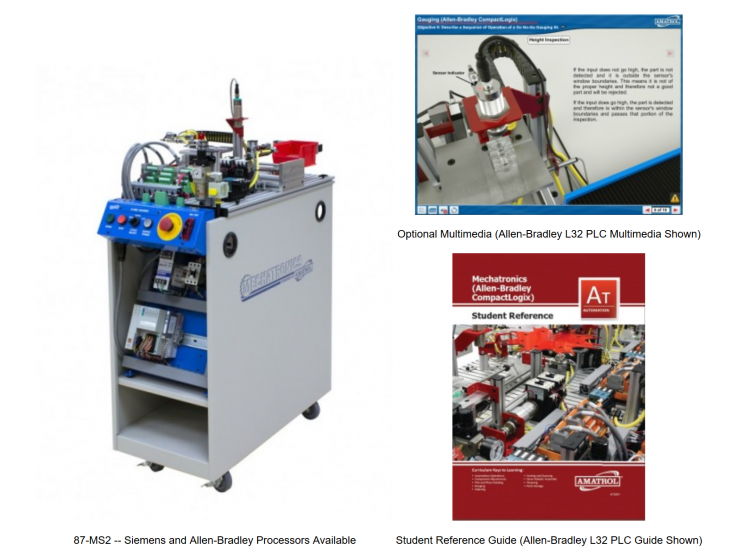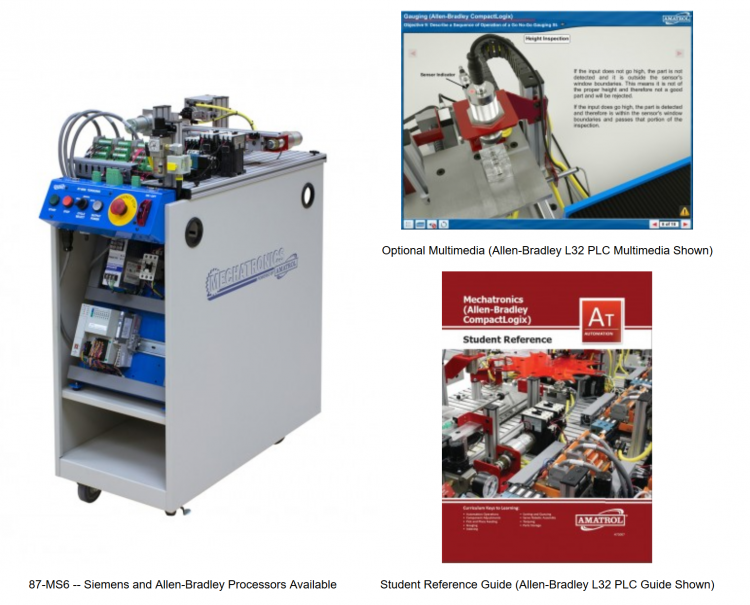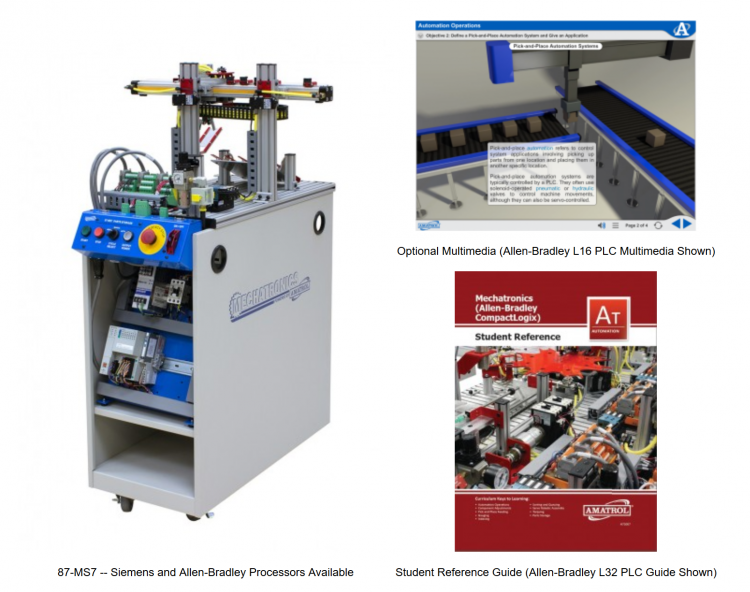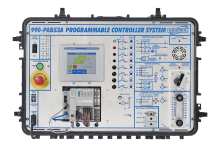Amatrol Mechatronics Learning System
Amatrol's Mechatronics Learning System teaches students a broad array of job-ready skills in integrated technologies as they work together in a team environment.
This learning system teaches students how to manufacture industrial quality working directional control valves. They develop the skills needed to enable processes to work together such as making precision physical adjustments. Modern industry leverages technology so that one set of equipment can make many products. Amatrol’s 870 Mechatronics System brings industrial realism to the classroom by allowing students to program it to assemble a minimum of four different variations of the valve.
Modern industry leverages technology so that one set of equipment can make many products. Amatrol’s 870 Mechatronics System brings industrial realism to the classroom by allowing students to program it to assemble a minimum of four different variations of the valve. The Mechatronics Learning System is compact, enabling it to fit into almost any teaching facility.
Individual Station Detail:
Nine stations make up a complete flexible manufacturing system. Each station is a small mechatronics system in itself with multiple, integrated technologies that can be used stand-alone or in various combinations, creating unlimited project capability.
Pick and Place Feeding Station 2
Gauging Station 3
Orientation Processing Station 4
Sorting / Buffering Station 5
Servo Robotic Assembly Station 6
Torque Assembly Station 7
Inventory Storage Station 8
CNC Mill Station 9
Hydraulic Press
Station 1: Mechatronics Pick and Place Feeding (87-MS1)
Amatrol’s 87-MS1, Pick and Place Feeding, is station 1 of the 870 Mechatronics Learning System. The 87-MS1 station is a small mechatronics system in itself with multiple, integrated technologies that can be used stand-alone or in combination with other stations. Industrial safety and operation are emphasized on all Amatrol mechatronic stations.
The Pick and Place Feeding station teaches interfacing, problem-solving, programming, sequencing and operation for pneumatic robots, material feeding systems, powered parts feeders, vacuum grippers, hall-effect sensors, and magnetic sensors. This station starts the process of assembling a working industrial directional control valve.
The 87-MS1 is a mobile workstation with slotted work surface that contains an operator station, powered feed module, pneumatic pick and place manipulator, finished parts storage module, parts set, a pneumatic distribution module as well as an electrical distribution module, an electro-pneumatic valve manifold, and a digital I/O interface module.
Learning Topics
- Powered Parts Feeder Operation
- Shock Absorber Adjustment
- Vacuum Switch Adjustment
- Vacuum Gripper Adjustment
- Material Feeding Systems
- Station Operation
- Electrical Sensors
- Electrical Pick and Place
- Pneumatic Pick and Place
- Mechatronics Safety
- Control Systems Concepts
- Mechatronics Introduction
- Pneumatic Manipulator Operation
- Powered Parts Feeder Sequencing
- Pneumatic Manipulator Sequencing
- PLC Program Design for Station Sequencing
Key Features
- Hall-effect sensor
- Vacuum gripper
- Powered parts feeder
- Pneumatic robot
- Material feeding system
- Magnetic sensor
- Photoelectric sensor
Station 2: Mechatronics Gauging (87-MS2)
Amatrol’s 87-MS2, Gauging, is station 2 of the 870 Mechatronics Learning System. The 87-MS2 station is a small mechatronics system in itself with multiple, integrated technologies that can be used stand-alone or in combination with other stations. Industrial safety and operation are emphasized on all Amatrol mechatronic stations.
The Gauging station teaches interfacing, problem solving, programming, sequencing and operation for go/no-go gauging, analog sensor adjustment, non-servo electric traverse axis, synchronous belt drive, ball screw drives and part rejection/transfer. The 87-MS2 performs a number of quality inspections in the process of assembling a working industrial directional control valve.
The 87-MS2 is a mobile workstation with slotted work surface that contains an operator station, ultrasonic measurement module, proximity gauging module, part transfer module, part reject module, finished parts storage module, parts set, a pneumatic distribution module as well as an electrical distribution module, an electro-pneumatic valve manifold, and a digital I/O interface module.
Learning Topics
- Ball Screw Drive Adjustment
- Synchronous Belt Adjustment
- Non-Servo Electric Traverse Axis Travel Adjustment
- Station Operation
- Electrical Sensors
- Electrical Pick and Place
- Pneumatic Pick and Place
- Mechatronics Safety
- Control Systems Concepts
- Mechatronics Introduction
- Non-Servo Electric Traverse Axis Sequencing
- Part Reject Module Sequencing
- Go/No-Go Station Sequencing
- PLC Program Design for Station Sequencing
Key Features
- Non-servo Electric Traverse Axis
- Magnetic Reed Switches
- Limit Switches
- Photoelectric Sensor
- Inductive Sensor
- Ultrasonic Sensor
- Analog Sensor Adjustment
- Go/No-Go Gauging
- Synchronous Belt Drive
- Ball Screw Drives
- Part Rejection/Transfer
Station 3: Mechatronics Orientation-Processing (87-MS3)
Amatrol’s 87-MS3, Orientation-Processing, is station 3 of the 870 Mechatronics Learning System. The 87-MS3 station is a small mechatronics system in itself with multiple, integrated technologies that can be used stand-alone or in combination with other stations. Industrial safety and operation are emphasized on all Amatrol mechatronic stations.
The Orientation-Processing station teaches interfacing, problem solving, programming, sequencing and operation for index tables, stepper motors, homing sensors, fiber optic sensors, part transfer, parts orientation, and capacitor sensors. This station performs the role of parts orientation and an optional simulated machine operation in the process of assembling a working industrial directional control valve.
The 87-MS3 is a mobile workstation with slotted work surface that contains an operator station, 8-station rotary index table, pick and place pneumatic robot, fiber optic gauging module, part transfer module, finished parts storage module, parts set, a pneumatic distribution module as well as an electrical distribution module, an electro-pneumatic valve manifold, and a digital I/O interface module.
Learning Topics
- Part Transfer Module Sequencing
- Homing Sensor Adjustment
- Stepper Motor Controller Programming
- Capacitive Sensor Adjustment
- Fiber Optic Sensor Adjustment
- Station Operation
- Electrical Sensors
- Electrical Pick and Place
- Pneumatic Pick and Place
- Mechatronics Safety
- Control Systems Concepts
- Mechatronics Introduction
- Stepper Motor Index Table Sequencing
- Parts Orientation Sequencing
- Station Sequencing
Key Features
- Stepper Motors
- Homing Sensors
- GMR (Giant Magnetoresistive) Sensors
- Inductive Sensors
- Capacitive Sensors
- Parts Orientation
- Part Transfer
- Index Tables
Station 4: Mechatronics Sorting-Buffering (87-MS4)
Amatrol’s 87-MS4, Sorting-Buffering, is station 4 of the 870 Mechatronics Learning System. The 87-MS4 station is a small mechatronics system in itself with multiple, integrated technologies that can be used stand-alone or in combination with other stations. Industrial safety and operation are emphasized on all Amatrol mechatronic stations.
The Sorting-Buffering station teaches interfacing, problem solving, programming, sequencing and operation for sorting, queuing, flat belt conveyors, photoelectric sensors, and inductive sensors. This station performs the role of sorting parts by material type in the process of assembling a working industrial control valve.
The 87-MS4 is a mobile workstation with slotted work surface that contains an operator station, belt conveyor module, part sorting module, buffer module, proximity sensing module, parts set, a pneumatic distribution module as well as an electrical distribution module, an electro-pneumatic valve manifold, and a digital I/O interface module.
Learning Topics
- Photoelectric Sensor Adjustment
- Flat Belt Conveyor Adjustment
- Station Operation
- Electrical Sensors
- Electrical Pick and Place
- Pneumatic Pick and Place
- Manual Operation
- Machine Operator Functions
- Mechatronics Safety
- Control Systems Concepts
- Mechatronics Introduction
- Sorting Module Sequencing
- Parts Queuing Module Sequencing
- PLC Program Design for Station Sequencing
Key Features
- Photoelectric Sensors
- Flat Belt Conveyors
- Queuing
- Sorting
- Inductive Sensors
Station 5: Mechatronics Servo Robotic Assembly - Pegasus II (87-MS5)
Amatrol’s 87-MS5-P2, Servo Robotic Assembly – Pegasus II, is station 5 of the 870 Mechatronics Learning System. The 87-MS5-P2 station is a small mechatronics system in itself with multiple, integrated technologies that can be used stand-alone or in combination with other stations. Industrial safety and operation are emphasized on all Amatrol mechatronic stations.
The Servo Robotic Assembly station teaches interfacing, problem solving, programming, sequencing and operation for servo robotics, gravity feeders, pick and place assembly, pneumatic screw feeders, and part insertion. This station performs the role of assembling a working industrial directional control valve using a combination of servo robotic and pick and place technologies.
The 87-MS5-P2 has two mobile workstations with slotted work surfaces that contain an operator station, Pegasus II servo robot with teach pendant, spool insertion module, screw feed module, spring/knob feed module, screw/knob engagement module, assembly shuttle module, parts presentation module, finished parts storage module, parts set, a pneumatic distribution module as well as an electrical distribution module, an electro-pneumatic valve manifold, and a digital I/O interface module.
Learning Topics
- Electrical Sensors
- Mechatronics Introduction
- Station Sequencing
- Screw Thread Engagement Module Sequencing
- Screw Feed Module Sequencing
- Part Insertion Module Sequencing
- Automatic Screw Feeder Adjustment
- Parts Feeder with Escapement Adjustment
- Station Operation
- Electrical Pick and Place
- Pneumatic Pick and Place
- Mechatronics Safety
- Control Systems Concepts
Key Features
- Pneumatic Screw Feeders
- Pick and Place Assembly
- Gravity Feeders
- Servo Robotics
- Part Insertion
Station 6: Mechatronics Torque Assembly (87-MS6)
Amatrol’s 87-MS6, Torque Assembly, is station 6 of the 870 Mechatronics Learning System. The 87-MS6 station is a small mechatronics system in itself with multiple, integrated technologies that can be used stand-alone or in combination with other stations. Industrial safety and operation are emphasized on all Amatrol mechatronic stations.
The Torque Assembly station teaches interfacing, problem solving, programming, sequencing and operation for an automated torque system, electric traverse slide, DC motor torque, variable speed motors and clutches. This station assures that the assembly components are properly tightened in the process of assembling a working industrial directional control valve.
The 87-MS6 is a mobile workstation with slotted work surface that contains an operator station, screw torque module, part clamp module, electric traverse module, a pneumatic distribution module as well as an electrical distribution module, an electro-pneumatic valve manifold, and a digital I/O interface module.
Learning Topics
- Motor Starter Overload Adjustment
- Motor Torque Adjustment
- Non-Servo Electric Slide Adjustment
- DC Motor Speed Adjustment
- Station Operation
- Electrical Sensors
- Electrical Pick and Place
- Pneumatic Pick and Place
- Mechatronics Safety
- Control Systems Concepts
- Mechatronics Introduction
- Non-Servo Electric Slide Sequencing
- Torque Clamp Module Sequencing
- Station Sequencing
Key Features
- Variable Speed Motors
- Clutches
- Electric Traverse Slide
- Inductive Sensor
- Magnetic Reed Switches
- Variable Speed PWM (Pulse Width Modulator)
- Pneumatic Gripper
- DC Motor Torque
- Automated Torque System
Station 7: Mechatronics Inventory Storage (87-MS7)
Amatrol’s 87-MS7, Inventory Storage, is station 7 of the 870 Mechatronics Learning System. The 87-MS7 station is a small mechatronics system in itself with multiple, integrated technologies that can be used stand-alone or in combination with other stations. Industrial safety and operation are emphasized on all Amatrol mechatronic stations.
The Inventory Storage station teaches interfacing, problem solving, programming, sequencing and operation for pick and place storage, pneumatic grippers and brakes, infrared sensors, and a programmable pneumatic traverse module. This station sorts the completed assemblies of working industrial directional control valves.
The 87-MS7 is a mobile workstation with slotted work surface that contains an operator station, a programmable position pneumatic robot, 4-channel parts storage module, a parts presentation module, a pneumatic distribution module as well as an electrical distribution module, an electro-pneumatic valve manifold, and a digital I/O interface module.
Learning Topics
- Infrared Sensor Adjustment
- Pneumatic Brake Adjustment
- Pneumatic Gripper Adjustment
- Station Operation
- Electrical Sensors
- Electrical Pick and Place
- Pneumatic Pick and Place
- Mechatronics Safety
- Control Systems Concepts
- Mechatronics Introduction
- Non-Servo Electric Slide Sequencing
- Torque Clamp Module Sequencing
- Station Sequencing
Key Features
- Programmable Pneumatic Traverse Module
- Infrared Sensors
- Pneumatic Grippers and Brakes
- Pick and Place Storage
- Magnetic Reed Switches
- Inductive Sensors
Station 8: Mechatronics Electro-Hydraulic Testing Station (87-MS9)
Amatrol’s Mechatronics Electro-Hydraulic Testing Station (87-MS9) allows learners to gain valuable product testing skills used in automated processes by studying topics like station operation and adjustment, module sequencing, and station sequencing. This learning system will allow learners to practice and study how products are tested on an automated line, how these skills are integrated within a larger automated process, and an example of how hydraulics are utilized on an automated line. The 87-MS9 requires either an Allen-Bradley CompactLogix or Siemens S7300 Mechatronics Learning System (870-MPC) and integrates seamlessly with Amatrol’s full Mechatronics System or can be used with just the Torque Assembly (87-MS6) and Inventory Storage (87-MS7) Stations.
This learning system features a hydraulic press module, part clamp module, hydraulic power unit, and more! Among other demonstrations, the 87-MS9’s clamp module will pick up a test valve and the hydraulic press module will hold a test manifold against the valve body. Learners will use these and other components to practice operating, programming, and adjusting real-world mechatronics equipment. Amatrol uses components that learners will find on-the-job in order to give the best opportunity to build confidence and industrial competencies.
Practice Programming, Operating, and Adjusting Real Automation Equipment
The 87-MS9 includes a hydraulic press module with horizontal hydraulic cylinder and electro-hydraulic valve; hydraulic power unit; pressure transducer system; part clamp module; an operator station with lockout/tagout; and more. Learners will use these components to practice vital mechatronics skills, such as: adjusting, programming, and operating a programmable electronic pressure transducer; designing PLC programs that sequence a pick-and-place manipulator and hydraulic clamp module; and operating an electro-hydraulic test system.
Study Station Sequencing Concepts and Knowledge, Then Apply Hands-On Skills
This learning system also includes Amatrol’s world-class curriculum which combines strong theoretical knowledge and concepts with hands-on skills for the best industrial competency-building on the market. The 87-MS9’s curriculum covers major objectives like the sequence of operation of an electro-hydraulic test station and the operation of an electro-hydraulic test station with manual/auto/reset functions. The curriculum is presented in a highly interactive multimedia format. This multimedia features stunning 3D graphics, videos, voiceovers of all text, and interactive quizzes and activities.
Amatrol’s World-Class Mechatronics Training with Siemens and Allen-Bradley PLCsThe 87-MS9 is just one of the world-class mechatronics training options offered by Amatrol. Other mechatronics stations include Pick and Place Feeding (87-MS1), Gauging (87-MS2), Orientation Processing (87-MS3), Sorting/Buffering (87-MS4), Servo Robotic Assembly (87-MS5-P2), Torque Assembly (87-MS6), Inventory Storage (87-MS7), and CNC Mill – Denford CNC Micromill (87-MS8M60).
Additionally, Amatrol offers Mechatronics PLC training with both Siemens S7300 and Allen-Bradley CompactLogix PLCs. While an Amatrol Mechatronics line can feature just Allen-Bradley or Siemens PLCs, this automated line also allows for a mix so that learners can train on industry’s two most widely-utilized PLCs simultaneously.
Student Reference Guide
A sample copy of the Electro-Hydraulic Testing Station Student Reference Guide is also included with the system for your evaluation.
Station 9: CNC Programming Training
The Mechatronic CNC Mill Training System (87-MS8M60) allows learners to use a Denford Micromill in conjunction with Amatrol’s Mechatronics Servo Robotic Assembly Station (87-MS5-P2). This combination provides hands-on practice for incorporating machining and CNC Mill integration within an automated lines process. In addition to integrated automation/machining skills, learners will study about CNC programming fundamentals. Because CNC mills are used to create a variety of parts and components, learners entering the manufacturing industry will find this learning system’s hands-on practice and real-world skills invaluable.
This system includes a variety of real-world components including a Denford CNC Micromill, mobile workstation, electro-pneumatic vise with filter/regulator, tooling package, robot-to-CNC interface, and an electro-pneumatic chip blower. The 87-MS8M60 also features worldclass interactive multimedia curriculum, an install guide, and a student reference guide.
Practice Real-World CNC Mill Skills Integrated with Mechatronics
When integrated within a mechatronics line, a CNC mill creates a highly efficient process for making precise parts that can be assembled further down the automated line. Specific to this learning system, the Servo robot on the Mechatronics Servo Robotic Assembly Station will load valve bodies into the Denford CNC Micromill where the valve body can have a design engraved on its side, have the mounting holes enlarged, or whatever is programmed by the learner. When the micromill’s process is complete, the Servo robot will unload the valve body and return it to the Mechatronics Servo Robotic Assembly Station.
The most prominent component included with 87-MS8M60 is the Denford CNC Micromill. The Micromill is a compact 3 axis milling machine with variable spindle speeds and feedrates which make it ideal for cutting a wide range of synthetic materials. It also features a removable door panel to allow robot loading and unloading, discrete I/O to communicate with robot, and USB I/O to communicate with a PC using the Denford CNC Micromill programming software.
CNC Programming Skills in an Interactive Multimedia Format
Learners will study basic CNC programming, CNC mill safety, and the fundamentals of operating a CNC mill before moving on to more advanced topics such as using a robot to load and unload parts and how a CNC mill can be effectively integrated into a mechatronics line. Additional topics include: linear interpolation, startup and shutdown blocks, tooling selection, locating zero, absolute and incremental positioning and circular interpolation. This curriculum is presented in a highly interactive multimedia format that features 3D animations, video, text with audio voiceovers, and quizzes.
Already Have a CNC Mill? Consider the Mechatronics CNC Mill Learning System (87-MS8M1)
The 87-MS8M1 includes all of the content and skills included with the 87-MS8M60, but excludes the Denford CNC Micromill. This allows customers access to Amatrol’s world-class curriculum and hands-on skills that already own a Denford CNC Micromill but want to teach CNC/automation integration skills.
Student Reference Guide
A sample copy of the Mechatronics CNC Mill Learning System’s Student Reference Guide is also included with the system for your evaluation.
Mechatronic CNC Mill Learning System - Denford CNC Micromill (87-MS8M60 )
FeaturesProduct
OptionsAdditional
Requirements
Key Features of Amatrol’s Mechatronics Programs
Amatrol’s Mechatronics Programs will quickly bring your mechatronics program online with the teaching tools you need to get the job done: extensive curriculum in print-based and either multimedia or eBook formats, high quality industrial hands-on training equipment, and computerized classroom assessment system..
Industrial Components and Safety
Amatrol’s Mechatronics Learning System uses industry standard components typical of what students will see in industry. Recreating the industrial environment in the classroom helps make students job-ready by building skills using the equipment they will find in the workplace.
Safety in an industrial setting is critical. Amatrol’s Mechatronics Systems teach students standard industrial practices and methods that support a safe workplace. On the full-size mechanical system, emergency stop circuits meet industrial standards as does the real world operator panel. Learners study the importance of lockout / tagout and procedures for correct machine start-up, shut-down, and emergency stop operation.
Wide Array of Advanced Technology
Amatrol’s Mechatronics Systems cover a broad array of applications across a balance of mechanical, electrical, electronics, fluid power and software to enable students to work effectively in virtually any industrial setting. As an example, the full-size mechatronics system includes eight types of electronic sensors, three types of electrical motors, four types of pneumatic actuators and 20 different mechanical power transmission components.
Individualized and Group Learning Formats
Amatrol’s curriculum is designed to give instructors the flexibility to teach students using either a self-directed or traditional lecture-lab format. The curriculum design allows labs to be implemented with a minimum of preparation.
Multimedia and Printed Curriculum Formats
Amatrol’s curriculum is well known for its breadth and depth of industry-relevant skills. Amatrol’s unique curriculum approach uses a task-based design where theory and hands-on activities are structured around industry-relevant tasks that enable students to develop job-ready skills. The curriculum easily supports either traditional lecture-lab format or individualized learning so students can move at their own pace.
The full-size Mechatronics Learning System boasts a robust ten Learning Activity Packets (LAPs). The first two LAPs concentrate on skills core to all stations: an introduction to mechatronics, systems concepts, safety, machine operation, sensors, pneumatic pick & place, and electrical pick & place. Integration skills across multiple stations, as well as skills specific to an individual station are covered in the balance. Overall system skills include discrete I/O handshaking, system start-up / halt, system stop / reset, and FMS programming.
All stations teach operation, sequencing and programming skills. Stations can be easily moved apart to function as individual workstations by releasing two quick connects and one plug-in cable. Stations can also be mixed and matched, enabling instructors to build and change the system as budgets allow or needs change. Many station combinations are available to support your needs.
On the Tabletop Mechatronics Learning System, the curriculum features an astounding breadth and depth of automation topics and skills. Key learning areas include: control system concepts, mechatronics safety, programmable controllers, PLC programming language, PLC program analysis, motor control basics, program development, timer instructions, time-driven sequencing, and much more!
Automated Lab Results
Amatrol’s SkillACE software makes documentation of lab results an easy task for teachers with a computerized data collection system and powerful reporting tools.
Product Options
- Mechatronics - Allen-Bradley L32 PLC Multimedia (M72007)
- MechaSIM Mechatronics Simulation Learning System - Siemens S7 (87-MSSS7)
- PLC Learning System (Siemens S7) (87-IOS-S7)
- Mechatronics HMI Terminal Learning System - Siemens S7, Type A (87-HMIS7A)
- Mechatronics Profibus Learning System (87-DPS7)
- Mechatronics Troubleshooting Learning System (Siemens S7 series) (87-FTSS7)
- MechaSIM Mechatronics Simulation Learning System - AB5300 (87-MSS-AB5300)
- PLC Learning System (Allen-Bradley CompactLogix 5300) (87-IOS-AB5300)
- Mechatronics Troubleshooting Learning System (AB5300) (87-FTS-AB5300)
- Mechatronics Manual Fault Insertion Module (87-MF1)
Additional Requirements
- Compressed air
- 110 VAC
- One of the following:
- Mechatronics Learning System for Siemens S7-300 (870-MPC-S7313)
- Mechatronics Learning System for Siemens S7-300 with Profibus (870-MPC-S7314)
- Mechatronics Learning System for Siemens S7-300 with Profibus and Profinet (870-MPC-S7315)
- Mechatronics Learning System for AB Compact Logix (870-MPC-AB5300)
- Mechatronics Learning System for AB MicroLogix (870-MPC-AB1200)
- Mechatronics Learning System - AB CompactLogix L16 (870-AB53A)



